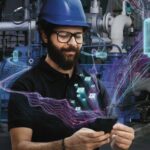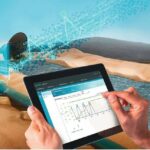Already in 2018, the World Climate Council pointed out the enormous challenge of limiting global warming to 1.5 °C. The Council has now met again and concluded that the pace and scope of previous measures and current plans are insufficient to tackle climate change. Mr. Lorenz, how can facilities in the process industry reduce their CO2 emissions more quickly?
Lorenz: Given their past CO2 emissions and energy consumption, the process industry must also take intensive countermeasures. However, efficient sustainability management is only possible if companies drive the digitalization and automation of their entire production. This means: from the development, planning, and optimization of production methods to the operation and maintenance of the infrastructure. With our portfolio, we are precisely addressing this issue: on the one hand, by keeping the CO2 footprint of our own products as low as possible. And on the other hand, by enabling and accelerating more sustainable production for our customers. And this is not just about newly built plants. Especially in Europe, we are mainly dealing with existing plants. Nowadays, it is possible to digitalize the production of these plants as well. In this way, we can make defined savings targets transparent and implement them more quickly. For many operators, however, retrofitting or upgrading existing production facilities is still a challenge.
In what way?
Lorenz: The structures of existing plants are often not completely digitally mapped. In addition, differences between the specification before construction („as-designed“) and the actual plant inventory („as-built“) make project calculation difficult. Changes to a plant are not always fully and correctly documented.
How can the plant operator proceed concretely now?
Lorenz: The first step is to reduce the use of fossil resources for plant operation as much as possible. Chemical recycling is a keyword: some innovative companies are currently working on converting complex waste like plastic, tires, or batteries back into oil or gas. They offer these recycled primary resources to chemical companies for their production, among others. Then, attention turns to plant components with particularly high energy consumption, such as reactors and distillation columns. By combining Advanced Process Control and digital twins, the process control of a plant can be optimized, and energy consumption reduced at the same time. Modern multi-variable model predictive controllers are used for this, which can be supplemented by further methods such as real-time optimization, long-term monitoring, and state estimation.
Which plant components do you have in mind here?
Lorenz: Valves that do not function properly, for example, increase the energy consumption of process plants. Asset management solutions based on artificial intelligence (AI) support the predictive maintenance of plant components such as pumps or valves. They recognize operating patterns and ensure maximum reliability and efficiency of all these components. Operators receive transparent information about where a component is currently in its life cycle and expected downtime.
Does Siemens offer products that fulfill this task?
Lorenz: For example, the Asset Performance Suite. It is an offering from the open and digital business platform Siemens Xcelerator. This plant asset management solution supports the predictive maintenance of plant components like pumps or valves and recognizes patterns in the operation of these components using artificial intelligence. This leads to the highest possible reliability and efficiency for all assets of a plant. Of course, our positioners SIPART PS2 and PS100 should also be mentioned.
What role does the overarching process control technology play for more sustainable production?
Lorenz: Process control technology can also be optimized in terms of more sustainability. The use of a process control system based on web technologies offers decisive advantages. Process control systems of such a new generation enable comprehensive sustainability management at the central point of plant control. By accessing information from various end devices of a web-based process control system like Simatic PCS neo, operators worldwide can access the control system and control their plants. This eliminates travel to individual plant locations for operation or instructions in the control system. In addition, existing plant components that have already run under other systems, such as Simatic PCS 7, can be integrated into the control system.
Are there more benefits or features in PCS neo that contribute to sustainability?
Lorenz: In addition to our software version 4.0, we recently brought new hardware to the market for our control system, such as the new controller generation Simatic S7–4100. Compared to the predecessor model, the power consumption is reduced by 50 percent – with increased performance. This significantly reduces the CO2 footprint. In addition, the controller no longer requires a buffer battery, making it 100 percent maintenance-free and conserves our natural resources.
Now I can already save quite a lot of CO2 equivalent with predictive maintenance and overarching control. Can the plant efficiency be further increased?
Lorenz: The next level of digital transformation offers even more potential for a sustainable process industry: the comprehensive digital twin. A digital twin corresponds to a virtual representation of a physical object, like the process plant. Over time, it continues to evolve and change – in the same way as the production process and its performance or the product it represents. Plant operators can use data captured in the real world to create closed optimization loops between the real and digital world throughout the value chain, gain actionable insights, and make safe decisions in the sense of holistic sustainability management.
How is the digital twin generated in practice?
Lorenz: Such a digital twin of the process is based on data from the real plant. With the help of simulation models and data science, a virtual plant is created. It is the basis for optimizing the process and sends forecasts and control measures back to the plant. In the resulting iterative cycle, simulation models are used to gain valuable insight into the actual state of the process in the real world and achieve a continuous improvement cycle.
Does this also work with existing plants, and which Siemens solution can I use for this?
Lorenz: The difficulty with existing plants is to first merge different data sources and formats or convert paper-based documentation into digital information. PlantSight offers a cloud-based solution here that brings all this data and information together, puts it in context, validates and visualizes it. In operation, this information can then be combined with artificial intelligence for even more profitable use. Another option is to use model-based solutions – such as our gPROMS software – to predict the behavior of process streams and thus improve plant performance and reduce CO2 and costs over the life cycle via the Digital Twin.
Production is largely optimized and my plants are under control around the clock. What else can I do now to save energy?
Lorenz: Industrial companies need to constantly monitor the energy consumption of their plants. To do this, they should implement company-wide energy management solutions – from recording energy data at the field level to company-wide energy analysis to identify key energy consumers and initiate appropriate measures. In this way, energy peaks can be avoided, for example. An automated load management system can automatically shut down systems and make them available again. Thanks to forecasts of the expected load profile, operators can also negotiate an optimized contract with their energy supplier.
What solutions does Siemens offer for energy management?
Lorenz: To keep a constant eye on company-wide energy consumption, Siemens offers Simatic Energy Management, a comprehensive, scalable and ISO 50001-certified portfolio of products and solutions ranging from energy data acquisition to energy analysis on edge and cloud systems. In this way, energy flows in production plants can be visualized, consumption data analyzed, energy savings potential identified, and efficiency and productivity sustainably increased.
Siemens AG, Nürnberg, Germany
Author: Daniela Held
Editor









